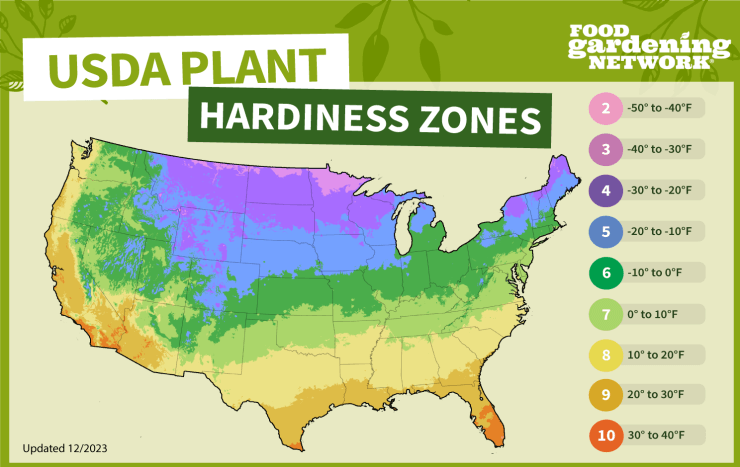
Note: The USDA updated planting zones in 2023, as featured here. We’ll be updating all of our Growing Guides over the next couple of months.
The mysterious USDA planting zone (aka plant hardiness zone) isn’t all that mysterious once you get to know it. It’s like the overlooked love interest in every 80’s RomCom. Always there in plain sight. Always ignored. Then one day, you wake up and realize that no, you can’t plant a banana tree in Maine. But you could have the best darn blueberries in the world. If only you had noticed earlier that your USDA planting zone was there telling you all along that blueberries are the way to go.
Alright, that might be a bit far-fetched (or not), but there’s a lot of happiness that can come from knowing your planting zone. As much as I love gardening, it can be a frustrating endeavor. Rabbits, deer, plant diseases, hail storms, seeds that don’t germinate, aphids, bad luck… there are so many things that can go wrong. So why add to that by planting vegetables or fruits that aren’t suited to your climate? Yes, that includes you, Idaho. You’ll need to get your mangoes at the supermarket.
Rather than a limitation, though, think of your planting zone as a world of magical possibilities, full of bright red tomatoes, deep yellow squash, the most purple eggplant you’ve ever seen, and brilliant green pea pods. It’s your guide to a garden that will bring you joy and happiness and rainbows (or at least enough colorful fruit and veggies that it will seem like a rainbow). Now then, what’s your zone?
Discover 7 top tips for growing, harvesting, and enjoying tomatoes from your home garden—when you access the FREE guide The Best Way to Grow Tomatoes, right now!
Your USDA planting zone: What it is and where to find it
Analogies aside, the USDA planting zone map is a guide that can help you determine where a plant is “most likely to thrive.” According to the USDA, “the map is based on the average annual minimum winter temperature, divided into 10-degree F zones.”
In 2023, the USDA updated their zones, as seen in this chart above, due to climate change, including the increasing average temperature of each zone. Plant hardiness zones are determined by the average lowest winter temperature in a specific area over a 30-year period. This helps us understand if certain plants can survive in that location based on its typical winter coldness.
In the U.S., these zones start with lower numbers in more northern latitudes. For example, northern North Dakota is zone 3 (it was zone 2 prior to his recent USDA update). Southern North Dakota and South Dakota are zone 4. As you move south, the USDA planting zone numbers go up. So by the time you get into Oklahoma, you’re in zone 7. You have to go to southern Florida, Texas, or some parts of southern California to get into zone 10. And if you’re interested in zone 12, you have to go to Hawaii or Puerto Rico. Basically, higher average temperatures equate to higher USDA planting zone numbers.
There’s always a caveat, though. And in this case, there are a few. Because these zones are based on temperatures, they also correspond to elevation and other factors that impact the local climate, such as proximity to the ocean or Great Lakes. For example, parts of New Mexico have lower zone numbers than Toledo, Ohio.
Here’s what’s cool, though. The lovely people at the USDA have a U.S. map of planting zones that you can zoom in on for each state. And if that weren’t enough, you can enter your zip code and find out precisely what your USDA planting zone is.
Check out the map and find out what your zip code zone is here. Or you can use our map to get a general idea of what your plant hardiness zone is.
Lastly, these zones are guides. They aren’t set in stone. It’s possible to grow something that is technically outside your zone. You may just find that it needs a little extra care or doesn’t do quite as well as you had hoped. But again, gardening is about the experience and not just the results, even if those results are usually delicious.
Have you grown plants that are outside your hardiness zone? How did it go?
Discover 7 top tips for growing, harvesting, and enjoying tomatoes from your home garden—when you access the FREE guide The Best Way to Grow Tomatoes, right now!





Too bad you can’t show Canada planting zone on your map.
Zone 5 on blue Chicago.
Yes, I grown outside my zone. I’m in 8A and I grew a subtropical plant, I just covered it during the winter. Low and behold it came back the next year. So you’re right it just takes a bit more care.
Are the magazines physically printed?
looking for a Canadian planting zone chart do you supply one or can you direct me to who can please